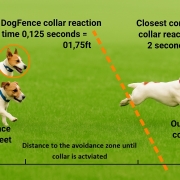Electric dog fences cruel or kind?
Are electric dog fences cruel or kind?
You’ve heard about electric dog fences and are either intrigued, appalled or desperate to know more! Surely an electric dog fence cannot be humane? Why does anyone need electricity to keep a dog in? Electric dog fences, wireless dog fences, containment fences why do I need one?
Dogs are playful, energetic animals with boundless curiosity. Naturally, they require plenty of exercise and are often given the freedom by their owners to roam the garden in the fresh air. However, some dogs choose to push the boundaries of their freedom by attempting to escape. It may be that they are after visiting another dog down the street, a farm, livestock or even next door’s rabbit! All different scenarios necessitating the installation of a good and effective fence to keep the dog safe and at home.
So What are electric dog fences?
Firstly, the name is a red herring. An electric dog fence is not an electric fence. An electric dog fence is actually an electronic fence but is referred to as electric fences. It’s a System that uses a central transmitter which is linked the boundary cable and computer collar worn by the pet.
Electric dog fences generally come in two forms: wired or wireless dog fences. A wired fence is pretty much exactly what it sounds like – a physical perimeter created around your garden by a wire, the route of which is determined by you or the company who installs it.
Types of electric dog fence
Wired dog fences
A wired electric dog fence is relatively quick to install and involves installing a boundary wire around the boundary. Ideally, the wire should be buried a few inches below the ground to avoid damage. The main criteria are that the cable must start and finish at the main base station to complete a circuit.
Wireless dog fences
Wireless dog fences dog not have the flexibility of the wired systems as they are really only suitable for very flat open properties. Wired fences send out a signal from a central base station and create a circular zone around the property. They require a clean line of sight so are not suitable for properties with buildings or trees that will shield the signal. Similarly, properties on steps or slopes are not suitable for wireless dog fences.
Wired electric dog fences are often seen as a more practical than their wireless counterparts as they can extend right to the perimeter of your property, whereas wireless systems have limited reach. You can also dictate the exact shape of the wired electric fence and create ‘out of bounds’ zones for your dog, which is a major bonus.
How does an electric dog fence work to keep the dog in?
The boundary wire acts as an antenna and carries a radio signal around the boundary. The dog or cat wears a small computer receiver collar. A “no go zone” is set around the boundary. As the pet enters the zone the collar wakes up and alerts the pet with a warning beep. If the pet continues further the collar gives out a static impulse. The impulse is harmless and is set by the trainer according to the dog or cats personality, age and breed. It is not a one size fits all but bespoke for each pet.
The question is, however, are these fences humane for your dog?
Are electric dog fences cruel?
Many dog owners make use of electric dog fences on a daily basis and sing their praises from the rooftops! Most owners will “feel” the impulse and agree that the word “electric” is far from the reality. A tingle or static shock would be more akin to the sensation delivered by the dog fence collar. Given the choice of a tingle or being run over or shot owners will attest that a small tingle is the better option. Also, research exists to support the understanding that electric pet fences are humane.
Research into electric dog fences
Animal welfare researchers at the University of Lincoln “found no evidence of long-term welfare problems in cats living with these fences, compared to control cats able to roam freely in and out of their owners’ gardens.” Indeed, researches commented that this was the best option for cats, as indoor cats can be prone to obesity and health issues are more prevalent for cats housed solely indoors. Of course, the statics for cat deaths and injuries speak for themselves.
Electric dog fences are also proven to genuinely train dogs to stay within the boundaries of their property. Dogs are intelligent animals and very quickly (Pavlov theory). They hear the beep and know to avoid the area due to the training. The effect produced by an electric dog fence is similar to a static shock you might receive from a carpet – it’s just enough to distract you, and not enough to cause pain.
Owners Testimonials
Owners point to the positive aspects of electric dog fences, such as their flexibility, effectiveness, and affordable price. The majority of owners who choose to install an electric pet fence are those for whom a physical fence has previously failed. It may be that installing a traditional fence would pose a problem due to planning restrictions or simply cost.
“Some years ago we lost a spaniel hit by a vehicle while chasing a pheasant out of the garden and across the road. The incident caused us and the motorist distress. Had the DogFence been in place we do not believe the incident would have occurred. Furthermore, the DogFence allows us and our dogs to enjoy our home and garden without unsightly, costly and less effective forms of boundary control.”
Our experience is that owners want to keep their pet safe but also give them freedom. Keeping pets indoors, tied up or in a run is far less humane than allowing a pet to roam and display natural behaviour.
How does the pet learn to use the fence?
As part of the installation process, the pet receives professional training. Using some visual markers in conjunction with the warming beep and impulse he quickly learns not to go too close to the boundary. The majority of customer’s report that their pet rarely received so much as a warning beep after their initial training.
Conclusion
If installed and handled correctly, a wired electric dog fence can work wonders in containing your dog. Your pet is kept safe and is able to enjoy plenty of freedom, making it an affordable and humane option. It also provides great peace-of-mind to you, the loving owner. You can rest assured that your pet is safe – no more worrying about them running off, or getting onto the road. With a DogFence system, you get all the benefits of leaving them to roam without the associated worry.
We have solutions for areas of all types and sizes, from small gardens right up to 350-acre estates. There are very few places where we can’t install an electric Dog fence – we can go under pathways and patios, or even over rivers and through woods! It is for this reason that here at DogFence Ltd we only offer installation for wired dog fences as the wireless fences do not offer the safety, reliability or flexibility of the wired versions.
Get in touch today to find out more. 03450 623623 or www.dogfence.co.uk
Ref: University of Lincoln Cat Study:
https://www.lincoln.ac.uk/news/2016/09/1265.asp
















